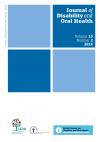Journal of Disability and Oral Health

- Cover Date:
- June 2014
- Print ISSN:
- 1470-8558
- Vol:
- 15
- Issue:
- 2
Development and qualitative evaluation of a communication tool for children with autism spectrum disorders and other communication difï¬culties
Effective communication is essential to establish rapport, explain procedures and give advice on preventing oral disease. Therefore children with communication impairments face potential barriers to receiving optimal dental care. Aims and objectives: To describe the development and qualitative evaluation of a child-centred chairside augmentative and alternative communication (AAC) tool; to observe its impact on delivery of treatment and gain the perspectives of children, parents and operators. Methodology: A draft paper-based AAC tool was developed using text and symbols (Widgit Health®). The content and format were amended during an iterative process in response to feedback from children, their parents and operators. A convenience sample of children with signiï¬cant communication impairments attending a specialist paediatric dentistry community clinic used the tool during dental visits. Data were collected by making contemporaneous ï¬eld notes of observations and by documenting verbatim comments from parents and operators. Data were subjected to thematic content analysis. The tool was further revised prior to publication. Results: Twenty children (17 boys, 3 girls) aged 3-14 years used one to four pages of the AAC tool. Known communication impairments (>1 may apply) included autism spectrum disorders (75%; n=15) and learning difï¬culties (35%; n=7). Forty percent had other medical conditions (n=8). The tool encouraged verbal communication, improved children’s cooperation with treatment and enhanced operator experience. Parents commented on its usefulness for their child, appropriateness of the format and the value of knowing the dental procedure sequence. Conclusions: This new child-centred AAC tool improved children’s communication and cooperation. Further evaluation is needed to determine whether its use may be applicable in other settings and with other patient groups.
Key words: Child, autism spectrum disorder, learning disability, communication, patient information, special care dentistry
Doi: 10.4483/JDOH_Harris11
- Article Price
- £15.00
- Institution Article Price
- £
- Page Start
- 33
- Page End
- 39
- Authors
- JC Harris, Z Marshman, JA Short
Articles from this issue
- Title
- Pg. Start
- Pg. End
- Development and qualitative evaluation of a communication tool for children with autism spectrum disorders and other communication difï¬culties
- 33
- 39
- Comparative assessment of caries risk using Cariogram model among individuals with intellectual disability in Udaipur, India – a cross sectional study
- 40
- 46
- National levels of reported difï¬culty in tooth and denture cleaning among an ageing population with intellectual disabilities in Ireland
- 48
- 53
